Zirui Zhu
How Does the Textual Information Affect the Retrieval of Multimodal In-Context Learning?
Apr 19, 2024



Abstract:The increase in parameter size of multimodal large language models (MLLMs) introduces significant capabilities, particularly in-context learning, where MLLMs enhance task performance without updating pre-trained parameters. This effectiveness, however, hinges on the appropriate selection of in-context examples, a process that is currently biased towards visual data, overlooking textual information. Furthermore, the area of supervised retrievers for MLLMs, crucial for optimal in-context example selection, continues to be uninvestigated. Our study offers an in-depth evaluation of the impact of textual information on the unsupervised selection of in-context examples in multimodal contexts, uncovering a notable sensitivity of retriever performance to the employed modalities. Responding to this, we introduce a novel supervised MLLM-retriever MSIER that employs a neural network to select examples that enhance multimodal in-context learning efficiency. This approach is validated through extensive testing across three distinct tasks, demonstrating the method's effectiveness. Additionally, we investigate the influence of modalities on our supervised retrieval method's training and pinpoint factors contributing to our model's success. This exploration paves the way for future advancements, highlighting the potential for refined in-context learning in MLLMs through the strategic use of multimodal data.
Sparse MeZO: Less Parameters for Better Performance in Zeroth-Order LLM Fine-Tuning
Feb 24, 2024



Abstract:While fine-tuning large language models (LLMs) for specific tasks often yields impressive results, it comes at the cost of memory inefficiency due to back-propagation in gradient-based training. Memory-efficient Zeroth-order (MeZO) optimizers, recently proposed to address this issue, only require forward passes during training, making them more memory-friendly. However, the quality of gradient estimates in zeroth order optimization often depends on the data dimensionality, potentially explaining why MeZO still exhibits significant performance drops compared to standard fine-tuning across various tasks. Inspired by the success of Parameter-Efficient Fine-Tuning (PEFT), this paper introduces Sparse MeZO, a novel memory-efficient zeroth-order optimization approach that applies ZO only to a carefully chosen subset of parameters. We propose a simple yet effective parameter selection scheme that yields significant performance gains with Sparse-MeZO. Additionally, we develop a memory-optimized implementation for sparse masking, ensuring the algorithm requires only inference-level memory consumption, allowing Sparse-MeZO to fine-tune LLaMA-30b on a single A100 GPU. Experimental results illustrate that Sparse-MeZO consistently improves both performance and convergence speed over MeZO without any overhead. For example, it achieves a 9\% absolute accuracy improvement and 3.5x speedup over MeZO on the RTE task.
Helen: Optimizing CTR Prediction Models with Frequency-wise Hessian Eigenvalue Regularization
Feb 23, 2024



Abstract:Click-Through Rate (CTR) prediction holds paramount significance in online advertising and recommendation scenarios. Despite the proliferation of recent CTR prediction models, the improvements in performance have remained limited, as evidenced by open-source benchmark assessments. Current researchers tend to focus on developing new models for various datasets and settings, often neglecting a crucial question: What is the key challenge that truly makes CTR prediction so demanding? In this paper, we approach the problem of CTR prediction from an optimization perspective. We explore the typical data characteristics and optimization statistics of CTR prediction, revealing a strong positive correlation between the top hessian eigenvalue and feature frequency. This correlation implies that frequently occurring features tend to converge towards sharp local minima, ultimately leading to suboptimal performance. Motivated by the recent advancements in sharpness-aware minimization (SAM), which considers the geometric aspects of the loss landscape during optimization, we present a dedicated optimizer crafted for CTR prediction, named Helen. Helen incorporates frequency-wise Hessian eigenvalue regularization, achieved through adaptive perturbations based on normalized feature frequencies. Empirical results under the open-source benchmark framework underscore Helen's effectiveness. It successfully constrains the top eigenvalue of the Hessian matrix and demonstrates a clear advantage over widely used optimization algorithms when applied to seven popular models across three public benchmark datasets on BARS. Our code locates at github.com/NUS-HPC-AI-Lab/Helen.
Grasp Stability Prediction with Sim-to-Real Transfer from Tactile Sensing
Aug 04, 2022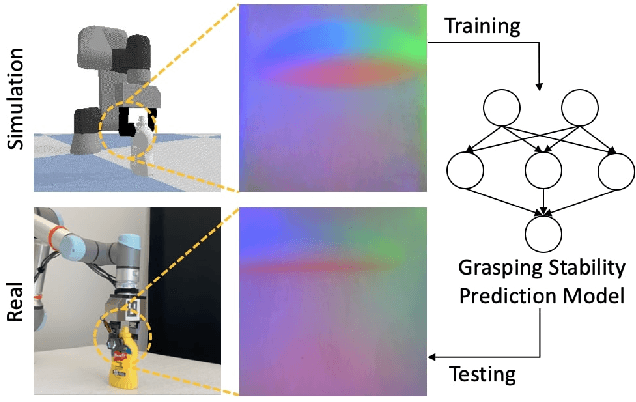
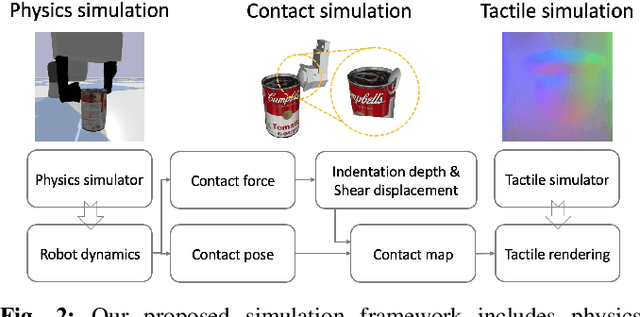
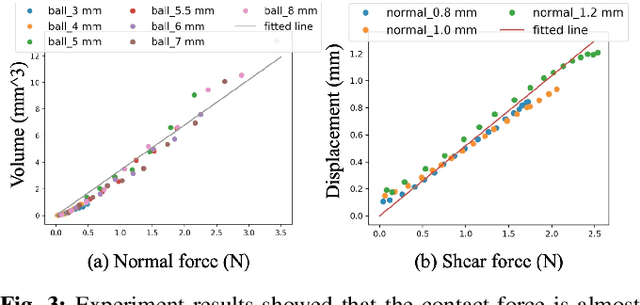
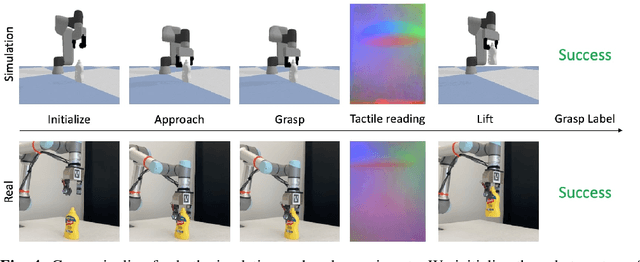
Abstract:Robot simulation has been an essential tool for data-driven manipulation tasks. However, most existing simulation frameworks lack either efficient and accurate models of physical interactions with tactile sensors or realistic tactile simulation. This makes the sim-to-real transfer for tactile-based manipulation tasks still challenging. In this work, we integrate simulation of robot dynamics and vision-based tactile sensors by modeling the physics of contact. This contact model uses simulated contact forces at the robot's end-effector to inform the generation of realistic tactile outputs. To eliminate the sim-to-real transfer gap, we calibrate our physics simulator of robot dynamics, contact model, and tactile optical simulator with real-world data, and then we demonstrate the effectiveness of our system on a zero-shot sim-to-real grasp stability prediction task where we achieve an average accuracy of 90.7% on various objects. Experiments reveal the potential of applying our simulation framework to more complicated manipulation tasks. We open-source our simulation framework at https://github.com/CMURoboTouch/Taxim/tree/taxim-robot.
Inhomogeneous Social Recommendation with Hypergraph Convolutional Networks
Nov 05, 2021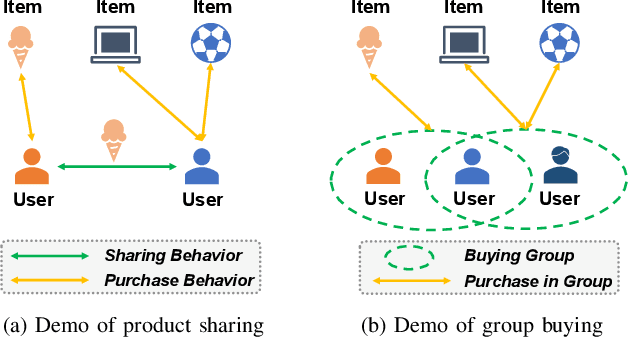



Abstract:Incorporating social relations into the recommendation system, i.e. social recommendation, has been widely studied in academic and industrial communities. While many promising results have been achieved, existing methods mostly assume that the social relations can be homogeneously applied to all the items, which is not practical for users' actually diverse preferences. In this paper, we argue that the effect of the social relations should be inhomogeneous, that is, two socially-related users may only share the same preference on some specific items, while for the other products, their preferences can be inconsistent or even contradictory. Inspired by this idea, we build a novel social recommendation model, where the traditional pair-wise "user-user'' relation is extended to the triple relation of "user-item-user''. To well handle such high-order relations, we base our framework on the hypergraph. More specifically, each hyperedge connects a user-user-item triplet, representing that the two users share similar preferences on the item. We develop a Social HyperGraph Convolutional Network (short for SHGCN) to learn from the complex triplet social relations. With the hypergraph convolutional networks, the social relations can be modeled in a more fine-grained manner, which more accurately depicts real users' preferences, and benefits the recommendation performance. Extensive experiments on two real-world datasets demonstrate our model's effectiveness. Studies on data sparsity and hyper-parameter studies further validate our model's rationality. Our codes and dataset are available at https://github.com/ziruizhu/SHGCN.
Towards More Efficient Federated Learning with Better Optimization Objects
Aug 19, 2021



Abstract:Federated Learning (FL) is a privacy-protected machine learning paradigm that allows model to be trained directly at the edge without uploading data. One of the biggest challenges faced by FL in practical applications is the heterogeneity of edge node data, which will slow down the convergence speed and degrade the performance of the model. For the above problems, a representative solution is to add additional constraints in the local training, such as FedProx, FedCurv and FedCL. However, the above algorithms still have room for improvement. We propose to use the aggregation of all models obtained in the past as new constraint target to further improve the performance of such algorithms. Experiments in various settings demonstrate that our method significantly improves the convergence speed and performance of the model.
 Add to Chrome
Add to Chrome Add to Firefox
Add to Firefox Add to Edge
Add to Edge